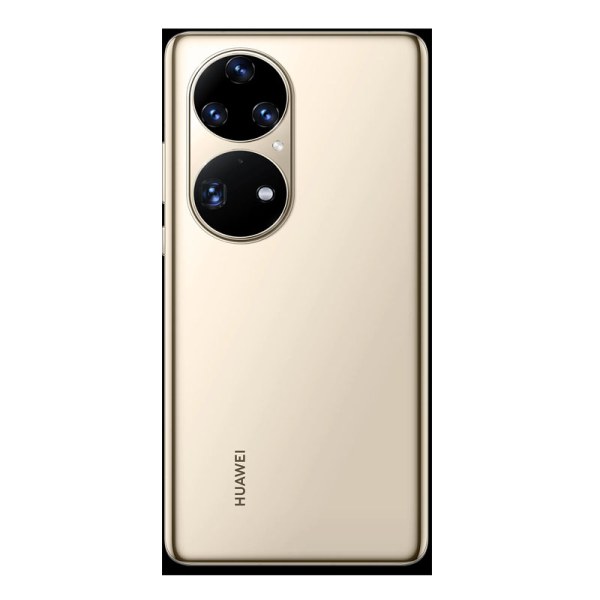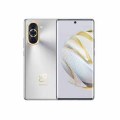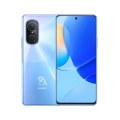Huawei P50 Price & Specifications



- CPU: Octa-core (1 x 2.84 GHz Kryo 680 + 3 x 2.42 GHz Kryo 680 + 4 x 1.80 GHz Kryo 680)
- RAM: 8GB RAM
- Storage: 128/256GB
- Display: OLED Capacitive Touchscreen, 1B Colors, Multitouch
- Camera: 50 MP, f/1.8, 23mm (wide), 1/1.28", omnidirectional PDAF, Laser AF, OIS + 12 MP, f/3.4, 125mm (periscope telephoto), PDAF, OIS, 5x optical zoom + 13 MP, f/2.2, 16mm (ultrawide), Dual LED Flash
- OS: Harmony OS 2.0
Huawei P50 Specs & All Features
General
| Device Type | Android |
| Model | Huawei P50 |
| Status | Available |
| Price | 119999 |
Design
| Type <strong>Design Type</strong> called form factor refers to a mobile phone's size, shape, and style as well as the layout and position of major components of phone. There are three major form factors seen in mobile phones => bar phones, folding phones and sliding phones. | Bar |
| Dimensions | 156.5 x 73.8 x 7.9 mm |
| Weight | 186 g |
| Colors |
Black, Gold, White |
Network
| 2G Network |
SIM1: GSM 850 / 900 / 1800 / 1900 SIM2: GSM 850 / 900 / 1800 / 1900 |
| 3G Network |
HSDPA 800 / 850 / 900 / 1700(AWS) / 1900 / 2100 |
| 4G Network |
LTE band 1(2100), 2(1900), 3(1800), 4(1700/2100), 5(850), 6(900), 7(2600), 8(900), 9(1800), 12(700), 17(700), 18(800), 19(800), 20(800), 26(850), 28(700), 32(1500), 34(2000), 38(2600), 39(1900), 40(2300) |
| SIM <strong>SIM</strong> (Subscriber Identity Module) is a small card that contains mobile network subscriber's account information. This allows the phone using the card to attach to a mobile network. The SIM card is most commonly associated with GSM and UMTS mobile networks. Moving a SIM card from one phone to another allows a subscriber to switch mobile phones without having to contact their mobile network carrier. SIM cards can also be used by a phone to store limited amounts of data, such as phone numbers and text messages. | Nano SIM |
| Dual SIM | Hybrid Dual SIM, Dual Standby, (Nano-SIM) |
Display
| Display Type <strong>Display Technology => </strong> A number of display technologies and types used in mobile phones => TFT (Thin Film Transistor), IPS (In-Place Switching), OLED (Organic Light Emitting Diode), AMOLED (Active-Matrix Organic Light-Emitting Diode), Super AMOLED (an even advanced version of AMOLED), Resistive Touchscreen (Resistive touchscreens contain two layer of conductive material with a very small gap between them which acts as a resistance), Capacitive Touchsceen (Capacitive touchscreen technology consists of a layer of glass coated with a transparent conductor) | OLED Capacitive Touchscreen, 1B Colors, Multitouch |
| Size | 6.5 Inches |
| Resolution | 1224 x 2700 Pixels (~456 PPI) |
| Pixel Density <strong>Pixel Density (PPI)</strong> is refers to the concentration of pixels on a particular display, measured in pixels per inch (ppi). Pixel density is calculated by dividing the diagonal pixel resolution of a display by its diagonal size, higher pixel density better display quality. | ~456 PPI |
| Touch Screen | yes |
| Features |
90Hz |
Media
| Audio Playback | yes |
| Video Playback | yes |
| Video Out | yes |
| FM Radio | yes |
| Alert Types | yes |
| Ring Tones | yes |
| Loudspeaker | yes |
| Handsfree | yes |
Camera
| Main Camera | 50 MP, f/1.8, 23mm (wide), 1/1.28", omnidirectional PDAF, Laser AF, OIS + 12 MP, f/3.4, 125mm (periscope telephoto), PDAF, OIS, 5x optical zoom + 13 MP, f/2.2, 16mm (ultrawide), Dual LED Flash |
| Image | yes |
| Video | yes |
| Camera Features |
Leica optics, Phase detection, Geo-tagging, touch focus, face detection, HDR, panorama, Video (4K@30/60fps, 1080p@30/60fps, 1080p@960fps; gyro-EIS) |
| Flash <strong>Flash Light => </strong> There is commonly two types of flash lights are used in camera mobile phones, LED Flash (LED flash offers lower power consumption with drive circuitry that takes up very little room, LEDs can be strobed faster than any other light source), Xenon Flash (xenon flash produces an extremely intense full-spectrum white light for a very short duration) | yes |
| Front Camera Front Camera | 13 MP, f/2.4, (wide), Panorama, HDR, Video (4K@30fps, 1080p@30/60/240fps) |
Software
| Operating System <strong>OS => </strong> Every computer system run on a base software called Operating System (OS). Operating System controls all basic operations of the computer (such as smartphone, PDAs, tablet computers and other handheld devices). The Operating System allows the user to install and run third party applications (apps), apps are used to add new functionality to the device. | Harmony OS 2.0 |
Hardware
| Chipset <strong>Chipset</strong> is a group of integrated circuits designed to perform one or a more dedicated functions, often with real time computing constraints, Popular smartphones are equipped with more advanced embedded chipsets that can do many different tasks depending on their programming. | Qualcomm SM8350 Snapdragon 888 4G (5 nm) |
| CPU <strong>CPU</strong> (Central Processing Unit) mostly known as processors, CPU processes instructions in order to carry out certain functions that make your device operate properly. Processors are often described as the brain of computers, smartphones and tablets, Smartphones and tablets rely on processors to carry out their every task, Processors are an incredibly important factor in selecting any type of computing device, including your smartphone. | Octa-core (1 x 2.84 GHz Kryo 680 + 3 x 2.42 GHz Kryo 680 + 4 x 1.80 GHz Kryo 680) |
| GPU <strong>GPU</strong> (Graphics Processing Unit) is a single-chip processor designed to rapidly manipulate and alter memory to accelerate the creation of images in a frame buffer intended for output to a display, This includes things such as lighting effects, object transformations, and 3D motion. | Adreno 660 |
| RAM (Memory) | 8GB RAM |
| Internal Storage <strong>Internal Storage</strong> is a data storage space (flash memory) mostly used in smartphones, tablets and other electronic devices where operating system, apps, music, photos, videos, files and other user data Is stored. | 128/256GB |
| Card Slot <strong>Memory Card Slot</strong> is a special slot for inserting a memory card. Memory cards allow you to expand the phone's built-in memory, A memory card (sometimes called a flash memory card or a storage card) is a small storage medium used to store data such as text, pictures, audio, and video, for use on small, portable or remote computing devices such as mobile phones, mp3 players, digital cameras. | Nano Memory Card, (supports up to 256GB) (uses shared SIM slot) |
| Sensors <strong>Sensors</strong> are electronic components that detects and responds to some type of input from the physical environment. The specific input could be light, heat, motion, moisture, pressure and location, The output is generally a signal that is converted to use in computing systems, a location sensor, such as a GPS receiver is able to detect current location of your electronic device. |
Accelerometer, color spectrum, Compass, Fingerprint (under display, optical), Gyro, Proximity |
Connectivity
| Bluetooth <strong>Bluetooth</strong> is a wireless communications technology for exchanging data between mobile phones, headsets, computers and other network devices over short distances without wires, Bluetooth technology was primarily designed to support simple wireless networking of personal consumer devices. | v5.2 with A2DP, LE |
| Wi-fi <strong>Wi-Fi</strong> is a popular wireless networking technology using radio waves to provide high-speed network connections that allows devices to communicate without cords or cables, Wi-Fi is increasingly becoming the preferred mode of internet connectivity all over the world. | Wi-Fi 802.11 a/b/g/n/ac/6, dual-band, Wi-Fi Direct, hotspot |
| Wi-fi Hotspot | yes |
| USB | USB Type-C 3.1, USB On-The-Go |
| GPS <strong>GPS</strong> The Global Positioning System is a satellite-based radio navigation system, GPS permits users to determine their position, velocity and the time 24 hours a day, in all weather, anywhere in the world, In order to locate your position, your device or GPS receiver must have a clear view of the sky. | Yes + A-GPS. Up to tri-band: GLONASS (3), BDS (3), GALILEO (2), QZSS (2), NavIC |
| NFC <strong>NFC</strong> (Near field communication) is a set of standards for smartphones and similar devices to establish peer-to-peer radio communications with each other by touching them together or bringing them into proximity, usually no more than a few inches. | Yes |
Data
Battery
| Battery Type <strong>Battery Type => </strong> Cell phones run on various kinds of batteries depending on the manufacturer, phone size or shape and features. There are basically four types of cell phone batteries => Lithium Polymer, Lithium Ion, Nickel Metal Hydride and Nickel Cadmium. | Li-Poly (Lithium Polymer) |
| Capacity <strong>Battery Capacity</strong> is a measure (typically in Amp-hr) of the charge stored by the battery, and is determined by the mass of active material contained in the battery. The battery capacity represents the maximum amount of energy that can be extracted from the battery under certain conditions. | (Li-Po Non removable), 4100 mAh |
Huawei P50:
The Huawei P50 is the latest smartphone offering from Huawei, designed to provide a seamless experience with its advanced features and sleek design. Here’s a closer look at what this phone has to offer.
Huawei P50 Specs:
The Huawei P50 runs on Harmony OS 2.0, offering smooth performance and user-friendly interface. It measures 156.5 x 73.8 x 7.9 mm and weighs 186g, making it compact and lightweight. Available in colors like Black, Gold, and White, it caters to different style preferences.
Huawei P50 Processor:
Powered by the Qualcomm Snapdragon 888 4G chipset and an Octa-core processor, the Huawei P50 ensures fast operation for all your daily tasks, whether it’s browsing, gaming, or multitasking. With 8GB of RAM, switching between apps is smooth and efficient.
Huawei P50 Camera:
The Huawei P50 excels in photography with its impressive camera setup. The main rear cameras include a 50 MP wide-angle lens, a 12 MP periscope telephoto lens with 5x optical zoom, and a 13 MP ultrawide lens. These lenses, coupled with features like Leica optics and Optical Image Stabilization (OIS), capture detailed and stable photos and videos in various conditions.
Huawei P50 RAM and Memory:
With options for 128GB or 256GB of internal storage, the Huawei P50 provides ample space for storing your apps, photos, videos, and more. Additionally, it supports Nano Memory Cards up to 256GB, ensuring you never run out of storage space.
Huawei P50 Features:
- Display: The Huawei P50 features a vibrant 6.5-inch OLED display with a resolution of 1224 x 2700 pixels and a high pixel density of 456 PPI. The display also supports a smooth 90Hz refresh rate, enhancing your viewing experience.
- Connectivity: Stay connected with Wi-Fi 802.11 a/b/g/n/ac/6, Bluetooth v5.2, GPS with support for multiple satellite systems, FM Radio, USB Type-C 3.1, and NFC for seamless data transfer and connectivity options.
- Battery: The Huawei P50 is equipped with a 4100 mAh battery with 66W fast charging support, ensuring long-lasting usage and quick recharges.
Huawei P50 Reviews and Price in Pakistan:
Early reviews of the Huawei P50 highlight its powerful performance, excellent camera capabilities, and sleek design. As for the price in Pakistan, the Huawei P50 offers great value for money considering its advanced features and specifications.
In conclusion, the Huawei P50 stands out as a flagship smartphone with its powerful performance, impressive camera system, generous storage options, and sleek design. Whether you’re a photography enthusiast or a multitasker, this phone promises to deliver a premium experience.
By focusing on user-friendly features and powerful performance, Huawei continues to set benchmarks in the smartphone industry with the Huawei P50.














